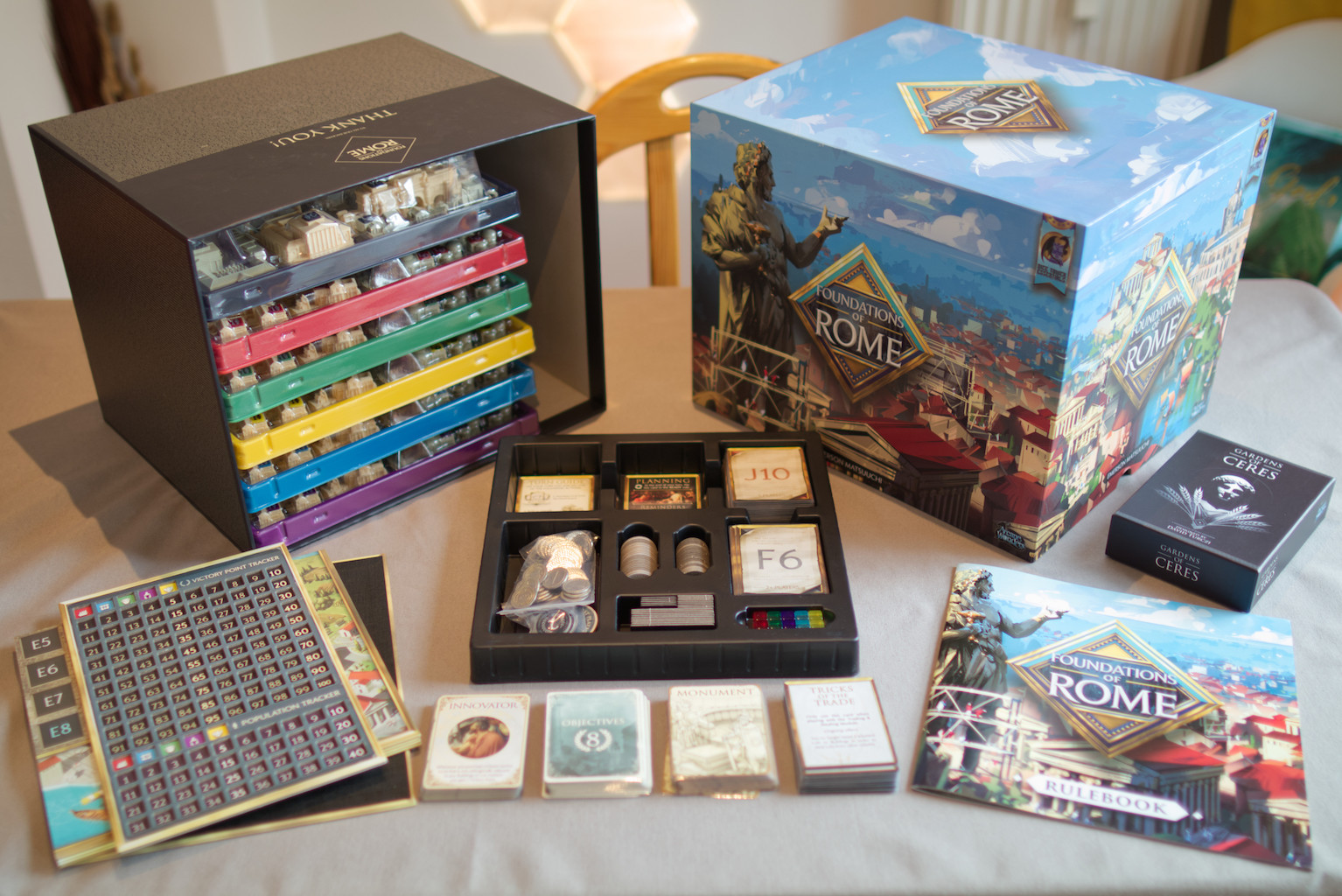Alright, let’s admit it, I like a good city builder. It’s not the most exciting or innovative concept in board gaming but it is sure satisfying to build your own little empire, street by street, building by building. Where the idea of actually establishing a trade empire in the Mediterranean or exploring the depth of space in real life is completely fictitious for most of us, managing a city seems almost … doable? That is if I just would have a couple hundred millions and enough political influence to tear down buildings on a whim of course. The point is, it’s a relatable yet not terribly exciting topic.
While exploring Foundations of Rome, I was reminded of how many city builders try to elevate their nature by means of presentation. I still remember fondly all the times we visited my cousin when I was young and I begged him to play his copy of the original Hotel Tycoon. At the time, it was an expensive game with TV ads that showed off the cool paper-plastic buildings, something that just blew my mind as a child (despite what with today’s view is a rather broken game system). There was also Cathedral, in all its shiny wooden glory (yet another expansive game I would never own), Big City with what was a ton of minis for the time (which I did own) and modern games like Quadropolis and Suburbia, the latter three being rather reasonably priced compared to the rest.
So you can imagine my excitement when I heard about the Foundations of Rome Kickstarter. However, when I saw the price tag and heard the simplistic rules, I decided it’s not for me. I’m rather new to backing games and still averse to spending so much money on a single game. I’m also in for the game, not the miniatures, and this seemed to have all the hallmarks of an overproduced Kickstarter game. Fast forward to a couple of weeks ago when the first reviews came in. They were mixed but surprisingly good all things considered. The price tag is still something to talk about, but I found a still in shrink copy for pretty much the Kickstarter price in an FLGS and thought to myself: I really want to check this game out. If you too are curious whether Foundations of Rome is worth your hard earned money or just a ton of plastic, reading this could either save or cost you a lot of cash. Either way, hope you have fun!
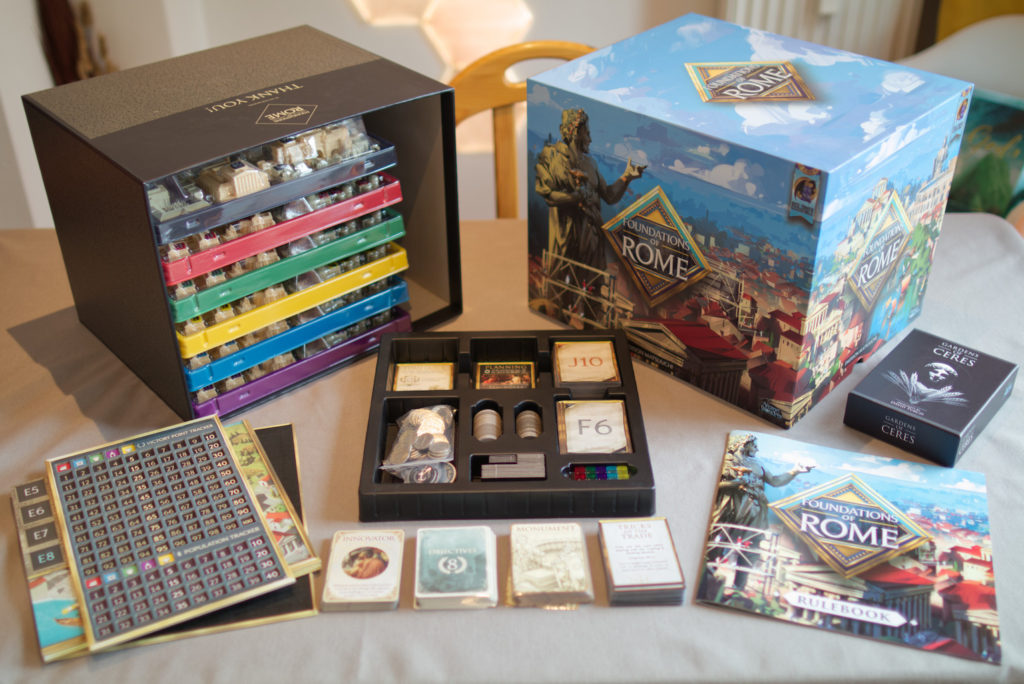
Inside The Box
I typically skip over components and dive right into the game, but let’s be honest: if you’re considering buying Foundations of Rome, it’s because of the presentation! My copy is the Emperor Pledge level with the added Foundations of Rome: Gardens of Ceres solo expansion. Inside the truly gigantic box (it’s approximately two times the volume of my already ridiculously big Suburbia Super Collector’s Edition), you’ll find trays containing the miniature buildings/markers for each of the five player colours (four if you have the Senator pledge level), a separate tray for the Foundations of Rome: Monuments Expansion (an optional extra if you have the Senator pledge level) and yet another tray that holds the game boards, cards, and other miscellaneous components. I was expecting the box to have some internal structure with racks like an oven, but the trays are just stacked on top of each other. You pull off the huge lid and have one of the sides of the box to access the content. It’s simple and it works. However, one needs to be careful to not move the box when open. It’s cardboard and quite big after all, so there isn’t a ton of rigidity and one could tear it easily.
Let’s take a look at the player trays: each tray has the exact same building miniatures and individual, colour-dependent lot and monument markers on the top. When you unbox the game for the first time you’ll find bags containing the small plastic labels for each building, both indicating the owning player as well as their function. Those have to be pressed into the respective slots on the buildings, something that you should do carefully and with the manual at hand. The fit is so tight that if you make a mistake, you will have a very bad time trying to get them out again. In fact, on 2-3 of my minis I had to use a sharp knife and remove a bit of plastic because the labels wouldn’t go in. The trays themselves are nice, double-layer so all the buildings slot in. Similar to Terra Mystica, constructing a building will reveal the income you get from that building so you can check it on your tray instead of searching for your building on the game board. There are two flaws I’ve found: for one, the VP you get for commercial buildings is not printed on the building, so you have to lift it off the tray to see it. The other thing is that the lot markers (used to indicate which lots on the game board you have purchased but not yet built upon) are unnecessarily close to the top row of buildings. So during game play, I tend to just pull them out and have them next to the tray.
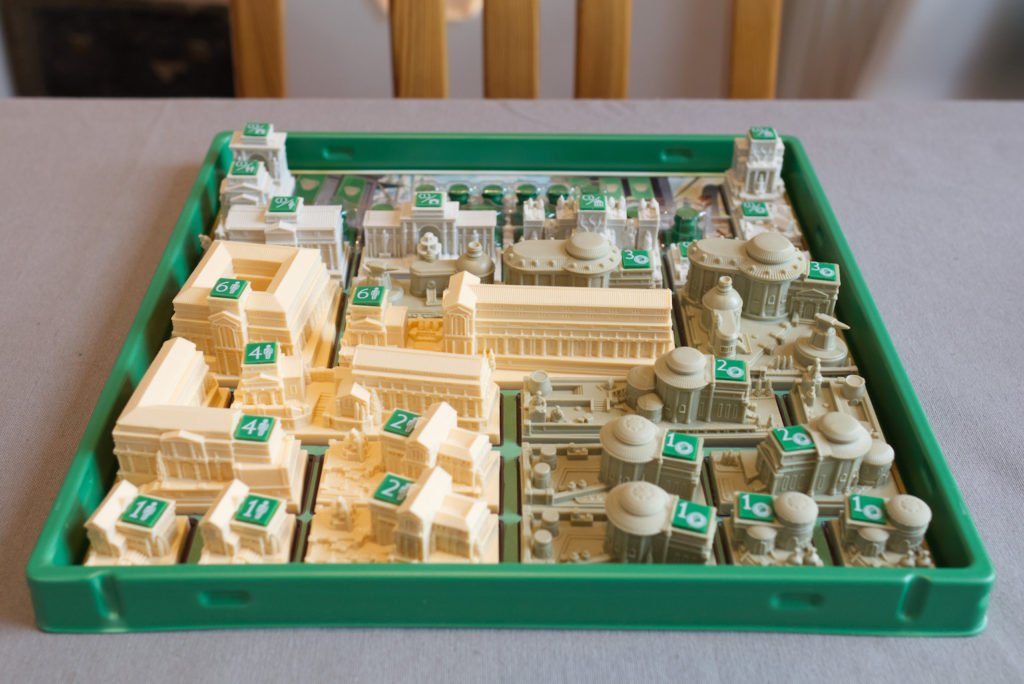
The monuments tray contains all the miniatures from the monuments expansion. Each one is a one-of and has a black label. At the start of the game, you shuffle the corresponding set of monument cards and reveal a number of them (e.g. 5 in a 2 player game). Those are the only monuments one can build during that game. Each monument has a requirement (e.g. has to be build on the edge of the board) that needs to be satisfied before you can built it and gives you a small additional bonus compared to what the standard buildings do. When you build one in-game, you’ll use one of your player-coloured monument markers to indicate that it’s your building. Once it is built, that’s it, it’s no longer available to other players.
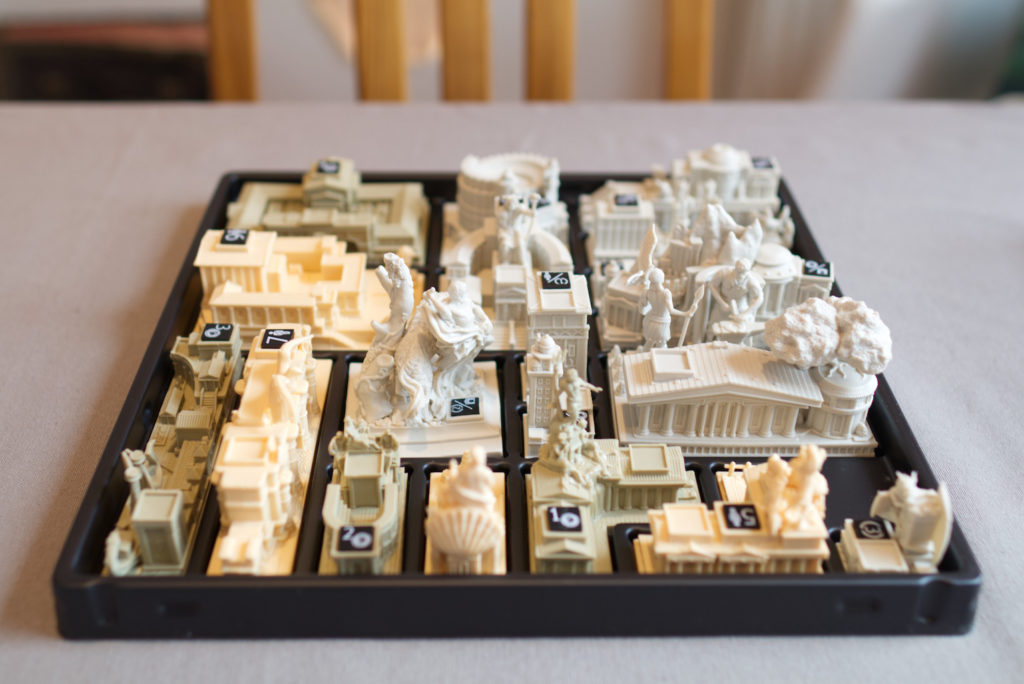
The final tray holds everything else you need including the content of the various optional modules. It’s nicely done and holds even sleeved cards. However, it’s tricky to get the bottom cards out because the bottom of the card well is at the same level as where you are supposed to insert your finger to pull the cards up.
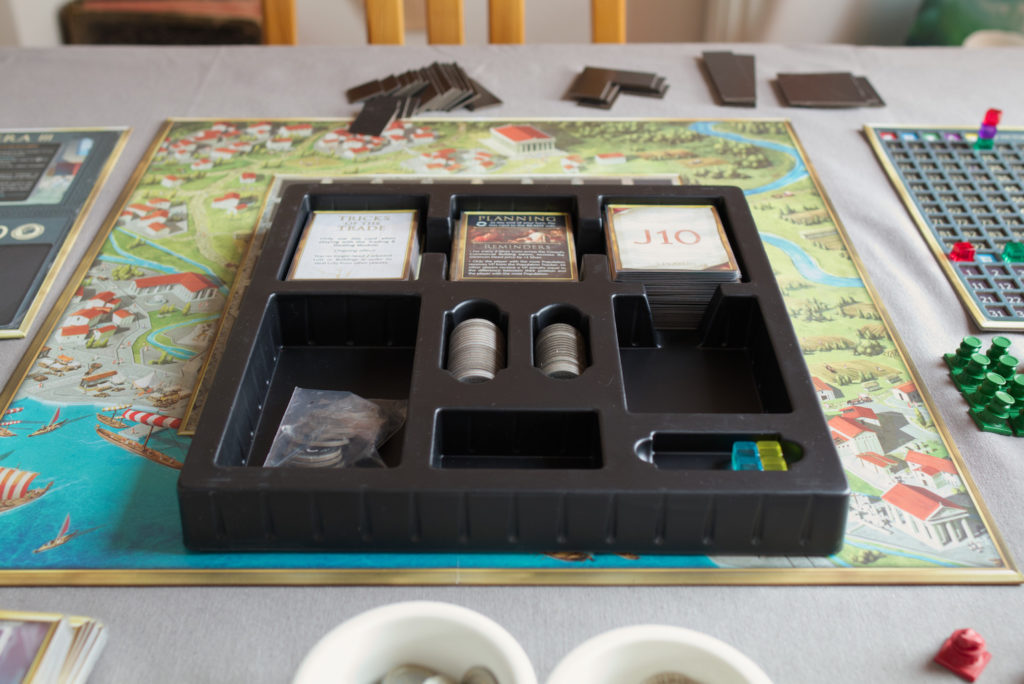
In addition, you’ll find the main game board (which is surprisingly small), the card market board and the scoring/population track board. The latter is double-layer which seems nice at first. However, the slots are so small that they just fit a single marker. If you have 2 or more players at the same score value, you’d better not bump the table. Here is what it looks like when you setup the 2 player co-op playing mode:

All in all, the trays and components work very well. Unfortunately, one of my monument miniatures is heavily warped and my attempts to heat it up and bent it back haven’t worked so far. However, the detail in all the miniatures is pretty great. The following is the Statue of Romulus which is about 4-5cm width, so this picture was taken pretty close to the mini:
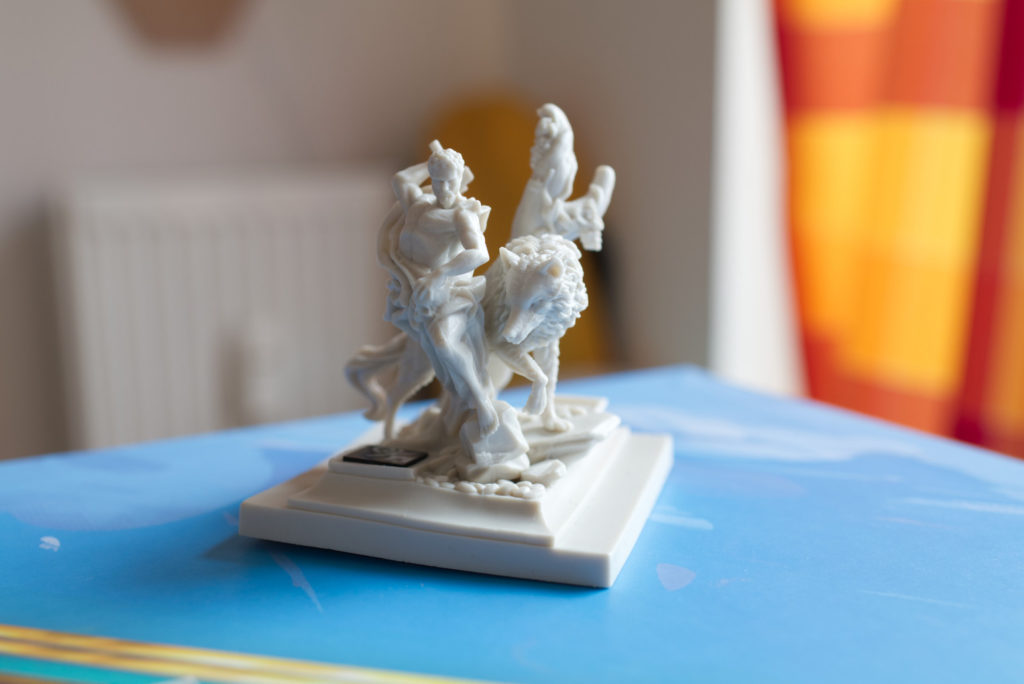
Finally, my copy contains metal coins of denomination 1 and 3. I find them rather disappointing. They have an okay weight and size to them, but the 3s are rather shiny, the 1s look quite dull, and both look very bland. If you have the chance, my recommendation would be to skip them and rather get some generic metal coin set you like.
Setup
Setup is pretty quick. Haul the giant, heavy box out of wherever you were able to store it (I still haven’t found a place for mine), hand out a tray to each player, setup the game board, market and scoring board. Depending on the player count, add/remove cards to the deed deck (each card shows a row and column, such as F7), shuffle it and hand six cards to each player who mark their lots with their player-coloured lot marker minis. Once you have placed a lot marker, you’ll no longer need the card and put it into a personal discard pile for later reference if necessary. Split the rest of the deed deck into three stacks and fill the deed market from the first stack. Each deck represents one era. Once depleted, you get a mixture of money and VP for your commercial buildings, victory points for civic buildings based on adjacent other building types, and finally there is population scoring. This one is a bit unusual: the player with the most majority gets his/her population value as VP plus a bonus. The second player get’s as much VP as the first player has population (without the bonus), the third player as much as the second has population, and so on. So your goal is not to have huge amount of population but just enough to have the most.
The Turn
When it’s your turn, you can either take income (5 coins plus whatever your commercial buildings generate), buy a new deed from the market or use your already purchased lots to build a building. Buildings come in various sizes and shapes (1 to 4 lots) and in the three categories already mentioned: residential, commercial and civic. Constructing a building doesn’t cost you anything except the action. You just have to have some empty lots that you own and fit the shape of the building. You can also build over existing buildings, even changing their type, as long as the building(s) you overbuild are smaller than the building you are trying to construct. This has an interesting dynamic because you can for example construct a 3-lot commercial building early and the game and later overbuild it with a 4-lot monument.

The market mechanism is pretty standard: more recently revealed deeds are more expansive than ones that have moved to the front of the line. If you buy one, you mark that lot with one of your lot markers and then add the card to your personal discard (=reference) pile. What is interesting is that you only have 8 lot markers and if you’re not careful, you can easily end up in a situation where you absolutely need to buy a deed, have the money, but cannot do it because you are out of lot markers and need to overbuild some with a building.
That’s pretty much it. The explanation of rules, especially if you play without modules, is really quick. The final scoring at the end of era 3 is slightly modified in that the coins your commercial buildings would produce is converted to VP.
Modules and Variants
If you buy the Emperor Pledge level, the game contains a number of optional modules that you can integrate into your play:
- Monuments: as already described, a random set of monuments is made available for purchase during the game. Those look great, but their effect does not seem to be as game changing as you might initially think. It’s good if you can construct one but it doesn’t immediately win you the game or so…
- Objective cards give you a certain goal that if you achieve it before the end of the game scores you additional VP. Haven’t had the chance to play with them yet so I cannot speak of how well balanced they are.
- Invocations are cards that are shuffled into the era decks. They are purchased like deeds but give you a one time effect, persistent effect or VP.
- Trading & Stealing: this consists of a few round cardboard markers. I haven’t played with it yet so I cannot speak to how interesting it is.
- “Will of the Consul”: this is a 2-4 player co-op mode. Every second round, the consul purchases the cheapest deed and builds a building (=cardboard tile) on that lot. If he buys another lot that is adjacent to one of his existing lots, the building automatically is replaced with a bigger building (also cardboard). At the end of the game, the human players have won if both individually have more VP than the consul.
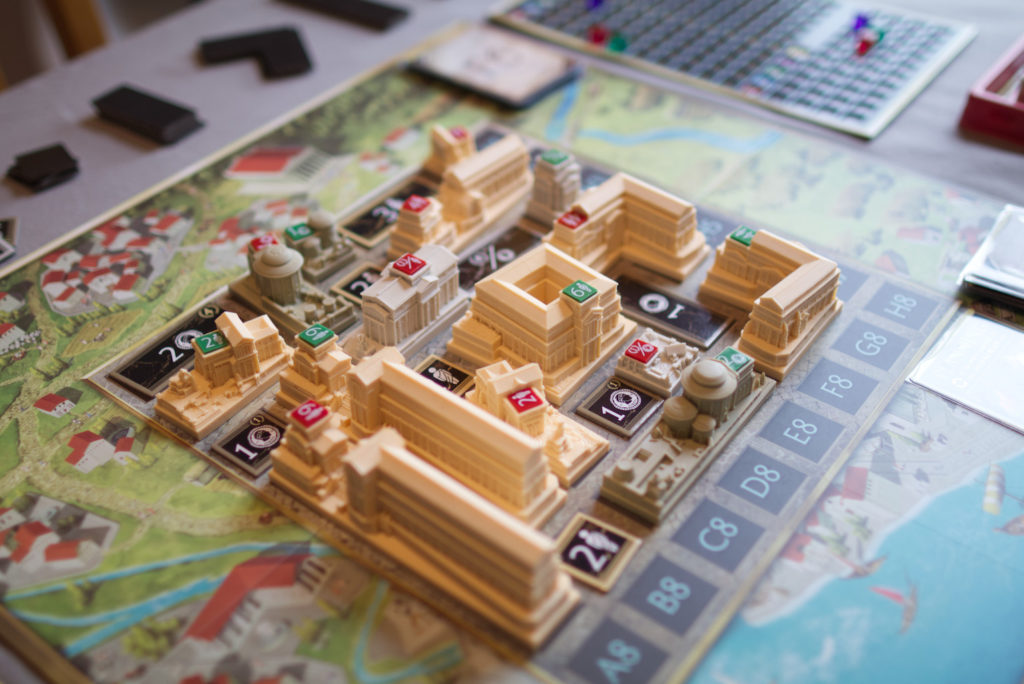
Solo
The Gardens of Ceres by David Turci is a sold separately solo-only expansion. In it, you get a set of cards which indicate the actions that Ceres will be doing. She buys deeds and uses them to construct garden tiles, cardboard tiles she places instead of the normal buildings. At the beginning of the game, you place 4 of her cards face-up on the board. Whenever it’s her turn, reveal the top card of the deck, check the number that is printed under the action and that number indicates which of the four cards on the board is triggered. Remove that card and slide the new card to the last position. This produces a Turci-typical automa where you can do a lot of planning/mitigation because you know the four possible options, just not which one she will take.
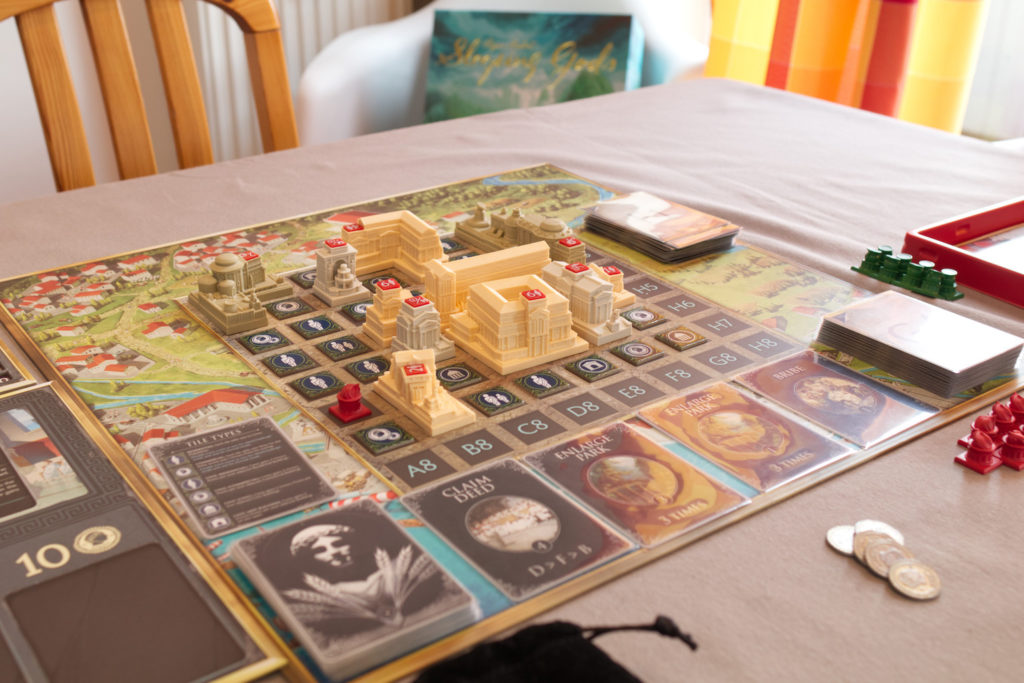
The garden tiles will give Ceres population, indirectly (via her bribe action) influence how much the price of certain deeds increase or represent civic buildings that score based on adjacency to your buildings. While the flow of reveal card, perform action is very nice, I’ve found this mode of playing solo lacking. While there are proposed ways to increase her difficulty, the randomness of what action she performs when seemed to have more influence in my games. If she performs the grow garden action without having any available lots to grow on, she just gets 3 points and if that happens multiple times, it gets rather easy. Also I have the feeling that you can skip building residential buildings completely and just buy a single one to participate in the population scoring. By focusing on commercial and civic buildings instead, this makes the game much more predictable and gives you a healthy cash flow because you no longer care how much population Ceres has. You get the same VP as her except for the bonus for being first.
While you can technically use the monuments expansion with this solo mode, I’ve never seen that Ceres actually manages to build one in any of my plays. None of the other modules can be used. She also never overbuilds, which I find one of the most interesting mechanisms in the game. So while the production is nice (the included bag for the garden tiles is of very nice quality) and it’s rather cheap to get, I’m not sure if I can recommend this expansion. I think I’m already over it…
Personally, I much more enjoyed playing Will of The Consul 2-handed. The consul does overbuilding, buying deeds to intentionally break up bigger potential building sites of the consul is important (in Ceres, you just have to prevent her from getting squares), you have two player sets that fill the city with buildings, and getting both colours to score more VP than the consul is a good challenge, and so on. You have to be careful that you don’t kneecap one colour by buying a certain deed with the other. And the city looks nicer because there are more minis and less cardboard tiles than with Ceres.
Both Ceres and Will of the Consul will play solo in approx 30min.
Conclusion
When I bought Foundations of Rome, it was with the thought that I would be able to flip it if I didn’t like it (the current price on the second hand market is rather ridiculous). However, to my own surprise, I’m quite taken with it. As I said in the beginning, I’m not the type of player that really cares that much about minis and the rules are on an almost Ticket to Ride-ish simplicity level. So it’s easy to dismiss Foundations of Rome without ever playing it.
When you do play it though, you discover there is something behind the simplicity which is on the border between simply unexciting and elegant purism. There doesn’t seem to be much there at first, but then you realise that that one avoidable mistake did cost you the game. Do you buy cheap deeds in hope of later being able to connect them or spend a bit more to get a bigger cluster sooner? If you spent too much, you have to spent turns gathering new money quite often. When do you construct a building and when better delay it 2-3 more turns? You can easily run into situations where you’ve reached the end of an era and didn’t have the chance to construct the building you already have the lots for. Or you carefully time your moves so you have exactly the money to buy a deed you need, only to realise that you have no more lot markers and therefore cannot buy it. The building types are also limited and I cannot count the number of times I had wished for another L-shaped 3-lot residential building because there is only a single one.
The general strategy is always the same: you try to buy deeds so you can create bigger lots, hopefully cutting off your opponent during the process, and do it is as cheap as possible. You want to have enough population to win the population scoring at the end of an era but not so much that you have constructed residential buildings you don’t really need. You need to get your income up but the opportunity cost is quite high. And sometimes a correctly placed 1-lot civic building can bring you more VP than 3 other buildings. So an otherwise worthless deed can become quite valuable if you or your opponent built the right type of buildings next to it. At first I was disappointed that there are only three types of buildings because it seemed to limit what you can do in the game. However, I’ve found that it is more about the correct timing and adjacency than “tech trees”. When do you buy what lot and when do you place what building where? How do you ensure to have enough money when that crucial deed you’ve been waiting for comes to market? There was one situation where I placed a monument incorrectly and that enabled my opponent to reap tons of points using a civic building.
Compared to Big City, Foundations of Rome fixes a number of flaws. In Big City, there were also lot cards but you didn’t buy them, you drew them and luck played a huge role. There were a few destructive take-that cards that could render certain lots valueless in an instant. The game was about getting your opponents to build cheap buildings so you can later on construct more valuable ones next to them. It often felt like a giant game of chicken where you try to wait as long as possible to build something. In Foundations of Rome on the other hand, you try to build large buildings as quickly as possible while keeping your options open to perhaps overbuild them with a different type later on. For example, if you have a 3-lot residential building and your opponent places a civic building next to it that benefits from it, you might want to buy a lot next to it so you can overbuild with a 4-lot commercial building, robbing your opponent of the VPs.
So there is “game” there, what about the production? The minis look great, have lots of detail and it’s of course lots of fun staring at the board as the city grows. There are some usability issues though. The board is rather small for how dense the buildings are placed and even on mid-size tables, you’ll have issues where a building obscures something behind it. The further you’ll have to sit away from the board, the worse it gets. While I haven’t played with all the modules yet, they feel like typical Kickstarter add-ons that have been tagged on after the core gameplay was done and I’m wondering how much play testing and refinement has been done. I especially wished the monuments were better integrated into Ceres and Will of the Consul and there would be a way to use the objectives as well. This could have pushed the replay value for solo players a lot.
There is also strange stuff: for example, you’re supposed to shuffle the Will of the Consul cardboard tiles and place them in stacks. But the back of the tiles has an irregular marble-like structure that is different on each tile. So you can easily spot which tile is on top of a stack if you played it once or twice. The bag of the Ceres expansion is of really nice quality but not large enough to get my hand in it. The scoring board is dual layer but causes problems if you have 2 or more players with the same score. The rules are in general well written but here and there are places where they are missing an essential sentence for clarifying something (causing a number of question-threads here in the forum). There is a summary of the end of era scoring on the market board, but it is underneath the deed decks and thus hidden during the era, making it unnecessary difficult for new players. To sum it up, there are things that I would expect a publisher to catch before releasing a game and I wonder why they are the way they are… luckily none of them are game breakers.
So, is all of this worth the 150-200 Euro (if you include taxes and shipping) asking price? I would say it depends on what else you have in your collection. For that amount of money, you can buy 4-5 really, really good games. Foundations of Rome on the other hand is a fun game, but not a must have game. If I had to choose, I’d rather have Suburbia in my collection for example. But, and that’s a big but, Foundations of Rome has a really nice presentation and flow. It’s so simple to play, it’s almost addictive. Within the first day of owning it, I had played 5-6 games of solo already. And it’s approachable so I could bring it to the table with pretty much everyone (as long as it’s my table, I really wouldn’t want to carry that box long distances). In many aspects, it reminds me of Cathedral: an essentially simplistic luxury object that you enjoy playing and in the end go “should we play another round”? I think I’ll keep my copy, despite the price … that is if I find a way to store it. That emperor pledge box really is pretty big…
Update Jun 4, 2022: I continue to play FoR solo quite regularly (despite the shortcomings of the solo modes) and it manages to keep its addictive quality. Hadn’t had the chance to play in larger groups yet, but with every 2 player game I play, I discover new small twists. As a friend I introduced the game to phrased it: “it’s really interesting, the kind of thoughts you develop while playing it”. Right now I’m fascinated about the timing of monuments. You have to build them early as they might be snatched away by the opponent, but if you build them too early, they can seriously backfire. In one game, I built a monument that gave me a lot population, only to have my opponent overbuild his civic building that scores for population adjacency and then re-build it right next to my monument. I had plus 5 population, he had plus 5 VP every era (and then constructed more of his residential buildings around it later on). I seriously had to consider to overbuild my own monument …
The reaction of another friend was also telling: I proposed to play FoR with 3 players – which I hadn’t done yet – and he was like “I like it, but we have so many other new games I’d rather play than replaying FoR”. I get the feeling it’s like introducing Backgammon or Go to a board gamer: good game, but you need to a) be interested in the tactics of FoR and b) play it multiple times to see why it can get addictively good. And quite a lot of players will never have an interest in that. So maybe one can sum it up as FoR is an “acquired taste”…?
Update Jun 15, 2022: I got a few more plays in, still enjoying the heck out of it despite me starting to lose a lot lately. Played a 2 player co-op on hard which was quite an enjoyable puzzle for both of us and we lost very narrowly. In post-game analysis, we found a simple move that wasn’t apparent at the time but could have won us the game, so just what you want from a co-op: defeat but a reason to play again. I have the feeling Will of the Consul will get a bit same-y over time, like a puzzle you crack once or twice and after that it loses its appeal.
Also managed to play head-to-head with objectives, player roles, and invocations. Enjoyed the former two although they only spice up the game and not fundamentally change it. The main focal point – at least in two player games – still seems to be the population vote and placing civic buildings. We start to get bigger and bigger amounts of VP from civic buildings and using overbuilding to optimise them. Getting back to the modules, objectives and player roles seem to be inoffensive but unbalanced which didn’t bother us that much. What was weird is that there is for example one objective that says “get 8 VP if you have the fewest lot cards” which can stall the game because neither player wants to buy another lot. Anyway, I think I’ll include both roles and objectives in future games just for the fun of them.
The invocation cards seemed odd. On the one hand it felt interesting to have larger era decks but I didn’t like the “take that”-nature of a lot of the invocation cards. They also seemed quite impactful, so much that you have to worry if you’re not the one to buy them. I don’t think I’ll add them to further plays.
